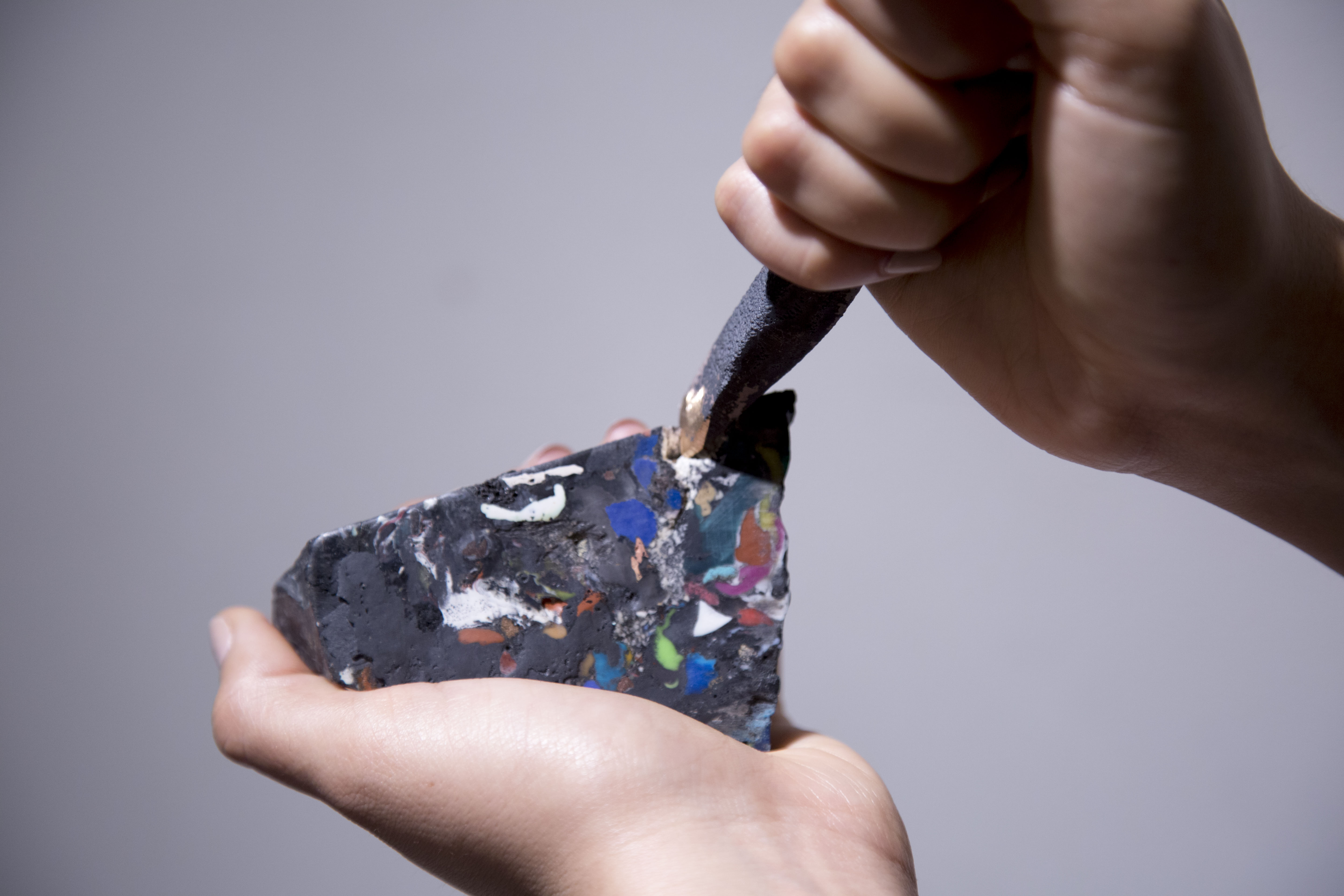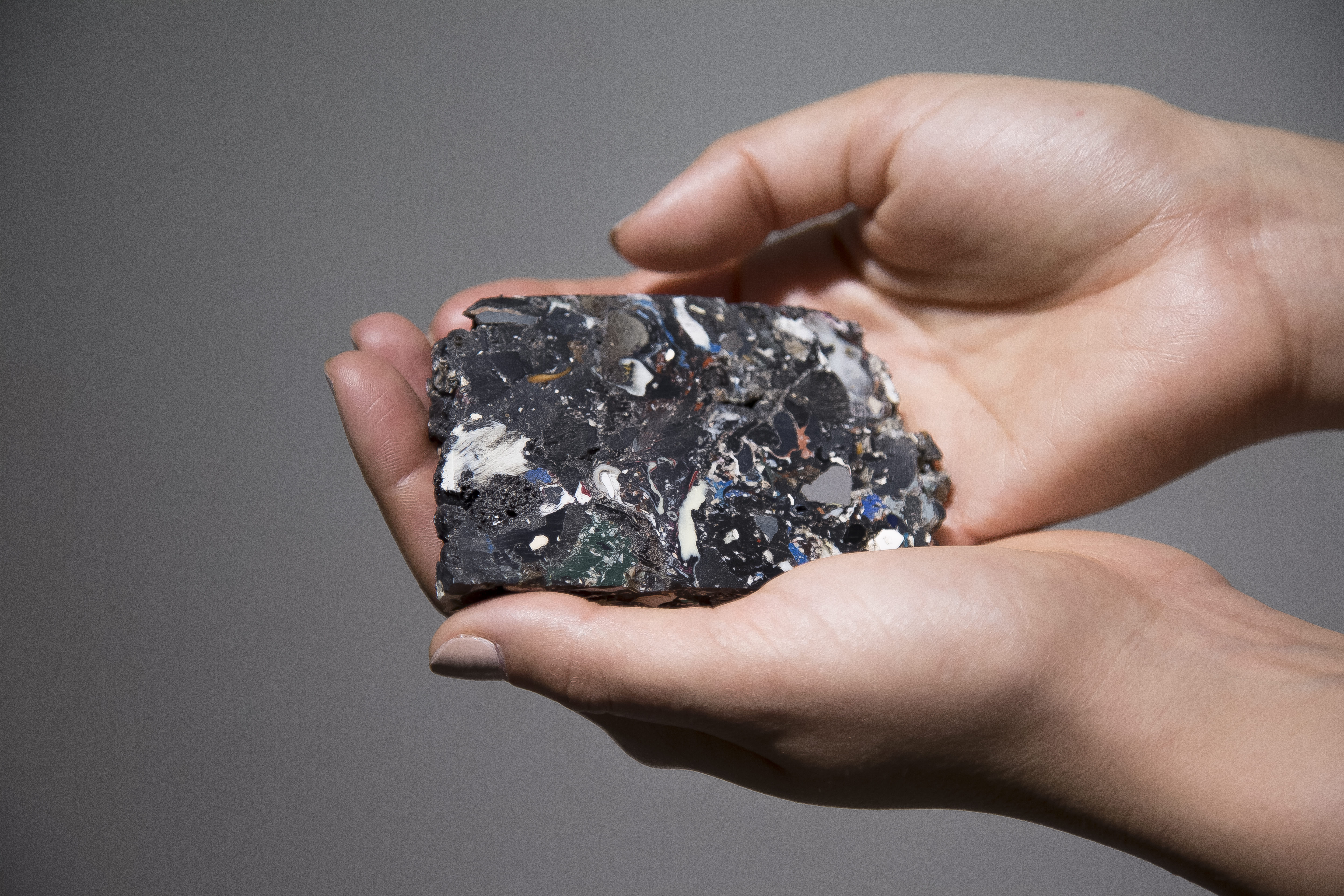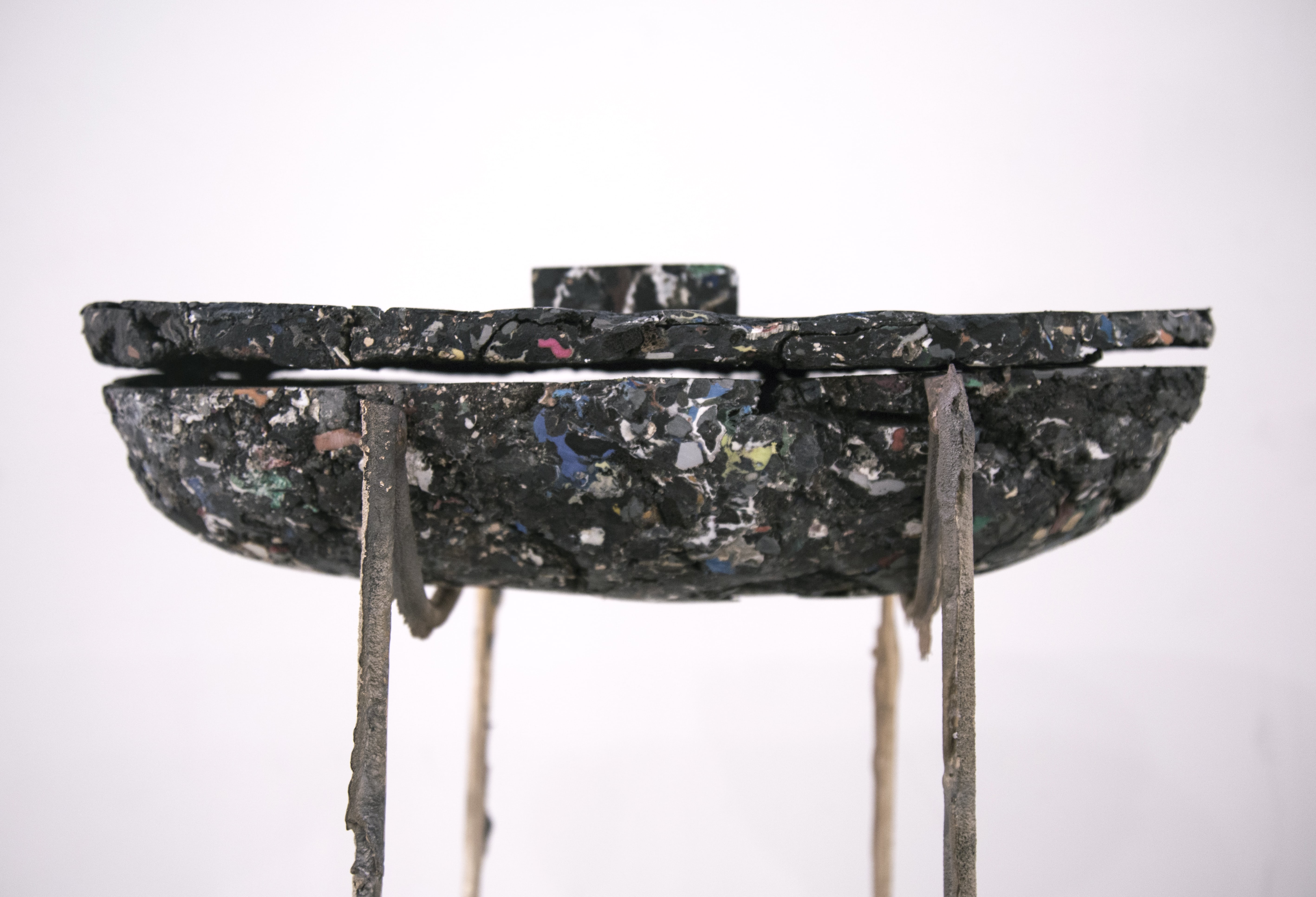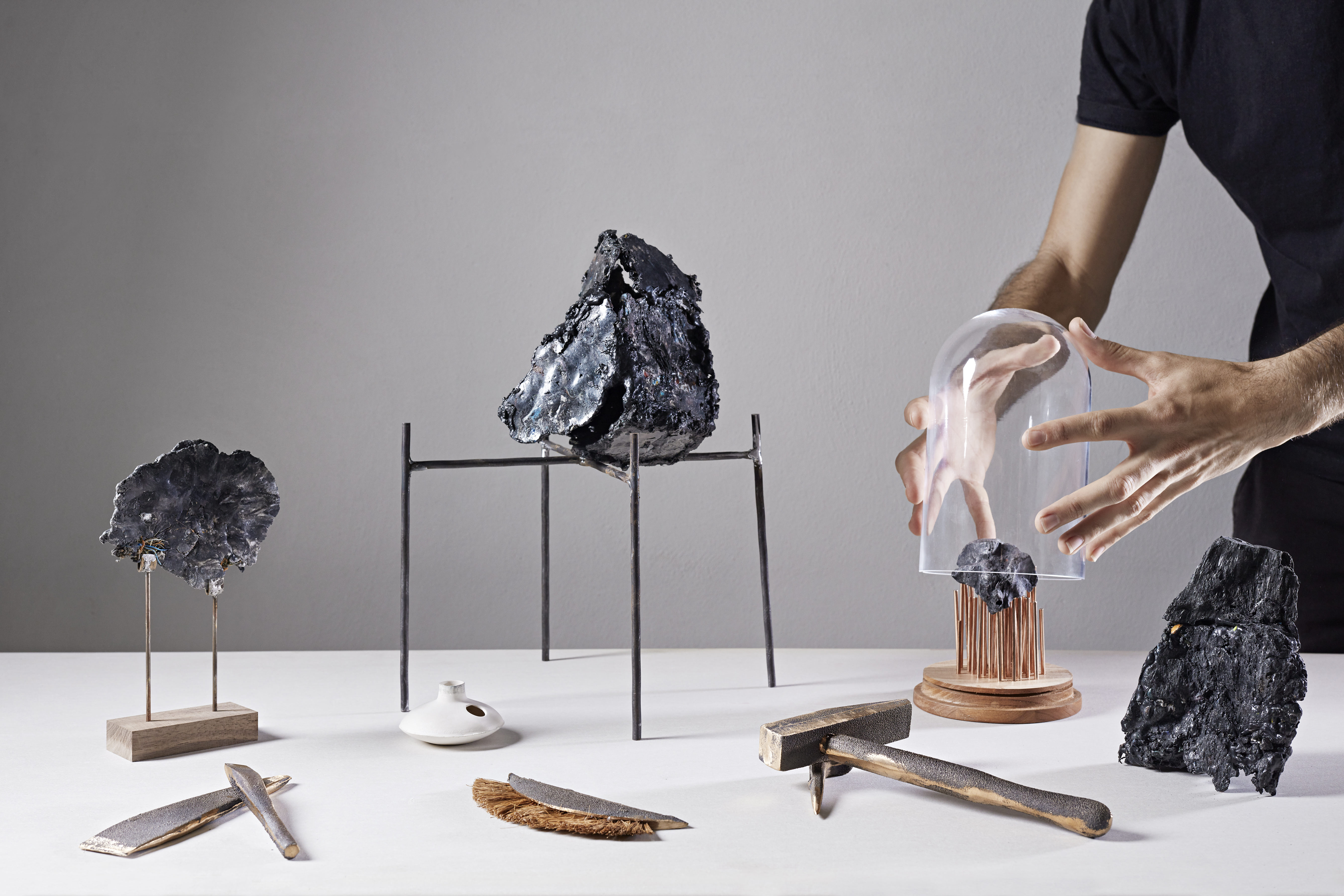What if plastics one day become a rare commodity that we desire and mine from the depths of the earth’s crust? By that time, plastic would be a rather different material. Shahar Livne offers a fast-forward to this next nature, by artificially geomimicing metamorphisms. She shares with us her speculative material: the “lithoplast”. We sat down with Shahar Livne, an Israeli-born designer who graduated from the Design Academy in Eindhoven. This week, she is showcasing her work at the Milan Design week. We spoke about her research into metamorphism as a design tool, and how this led her to envision the future of plastics.
Material narratives through metamorphism
“I’m a material designer. I’m interested in the philosophical and cultural aspects of materials. I aim to use them to tell a story.” One of the many materials that may tell a story, are rocks. “Over time, rocks go through a lot of transformations inside the Earth.” One of these transformations, is metamorphism. “This is a natural process, resulting in natural rocks, through which I am uniquely able to tell a story.” The Earth’s history is told by the rock-layering of the earth’s crust. Humanity is uniquely present in that story, by leaving a global mark on our technosphere. The most prominent material-marker of humanity, are plastics.

Exploring plastics
“Plastic is the first man-made material that we have changed on a molecular level. Plastics are made from the natural material of oil, and were developed to imitate and enhance nature." “I drew upon an essay by Koert van Mensvoort, and was particularly inspired by the concept of Hypernature. I think plastic is a hypernatural material. With plastics, we’re able to model and control nature.”Plastics are made to be durable, and may survive much longer than we had imagined. There is no place in the world that is free from plastics anymore.” Despite our efforts of recycling, and cleaning up the oceans, plastics will most likely be a future fossil. Shahar dares to accept this scenario and explores what this future may look like.
“Plastic is a hypernatural material”
“Nature is already taking plastic into itself. At some point, plastic hybridized with natural materials.” The first example of this hybrid material, are ‘plastic conglomerates’. These are nature-made-rocks that harbor pieces of plastic within them. These have gone through the earliest stages of the rock-cycle, similar to the process by which dead shellfish pressurize into limestone, making up the iconic white cliffs of England. However, it's possible that materials like rock or plastic stay within the earth’s crust for longer. This is when the natural process of metamorphism takes place. Under high pressures and temperatures, limestone may turn into marble, or charcoal turns into diamonds. “I wondered, could plastics last through the full rock-cycle? So, I started talking to geologists. They agreed that our plastics will most probably one day be metamorphosed.” “That vision of the future, is what grasped me. That’s how I got to my speculative material version of the future. A newly created material: the lithoplast.”
“Nature is already taking plastic into itself. At some point, plastic hybridized with natural materials”

Presenting the future of plastics
“To make the lithoplast, I’m geomimicing something that doesn’t happen in nature just yet.” “In natural settings, I expect that all kinds of plastics will metamorphose together with other minerals. To mimic this, I mix the plastics with minestone and marble dust. This distinguishes my method from 3D printing, where you can only use certain types of plastics and have to divide them yourself.” “To mimic metamorphism, I have access to a huge press. This machine can expose my mix to such high pressures and temperatures that the material completely changes. The material stretches, and becomes malleable.”Malleability is a celebrated characteristic of plastics; you can make it into any form you like. “However, the timespan for molding plastics in traditional methods, industrial plastics and 3D printers, only lasts a few seconds. This time-frame makes plastic inherently a machine-made material.”
“In the future, we may rediscover this beautiful material of our wasted plastics, and start mining them”
“What I discovered, is that through my method of metamorphism, the lithoplast stays malleable for much longer. We think this happens due to the mixture I use. This unique aspect allows me to mold the material by hand - as if it is clay. This interaction with the material, is much more like craftmanship.” Her next-material may envision a goldsmith of the future: the plastic smith!Her work envisions a more positive view on our waste culture. “What I think will happen, is that we will reach a point where we won’t be able to make plastics anymore. At that point, we may rediscover this beautiful material of our wasted plastics, and start mining them.” “When I tell people that I’m not recycling plastics, but envisioning a far future with fossilized plastics in it, some people may get angry. I think that makes sense: many of us put a lot of effort into recycling our plastics, we simply don’t want to see our plastic waste become a part of nature. I want people to start thinking differently about plastics, on a larger timescale.”

Milan design week
Shahar is excited to present her work during Milan design week. She’ll be doing two exhibitions as part of her metamorphism research. “Firstly, I’m invited by the organization of Ventura Future to exhibit in their collection on future materials and technologies. Here, I will be treating the lithoplasts like clay, and make vases with them, that either are ‘rough’ or really ‘fine’. So, the vases change in meaning from looking really natural to looking really synthetic.” “I’m also exhibiting with Dutch Invirtuals, a design collective. One of their exhibits is exploring the future of mining, and is part of the exhibition “Mutant Matter”. Here I will present the lithoplast like altars, to illustrate the idea that we could also be worshipping plastics instead of wasting them.”
The future of the lithoplast
In the future, Shahar hopes to publish her research on metamorphism in book form. Her graduation research will be a part of this. “This research will explore our perceptions on the natural-born and man-made, our cultural uses of plastics, and I’ll research the idea of craftsmanship.” Her favorite part of her designs, lies in the dialogue it invites. “I'm now developing a methodology on material research and design, whilst doing my residency at the ‘materials experience lab’ at TU Delft. I realized that what I like most about my materials such as the lithoplasts, is how I can ask people lots of questions with it.” “One of my favorite questions I like to ask people about my work is: 'If we are natural, and we are making plastic, then is plastic not a natural material?' ”Think about it. Thank you Shahar Livne, for sharing your viewpoints with us! We are looking forward to your exhibit in Milan, and the many more next-materials you may make.

Share your thoughts and join the technology debate!
Be the first to comment